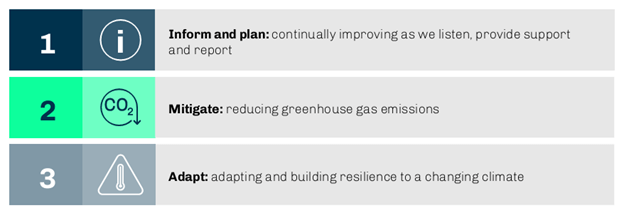NSW EPA releases its Climate Change Policy and Climate Change Action Plan 2023-26 – Planning for the Net-Zero Future
-
Étude de marché 3 février 2023 3 février 2023
-
Asie-Pacifique
-
Droit de l’environnement
In this first of our series of articles we unpack the key features of the Policy and Action Plan and provide our insights on the EPA’s initial actions to gather information and implement steps to require key regulated industries to develop and implement climate change mitigation and adaptation plans.
The Policy and Action Plan
In the August 2021 decision in Bushfire Survivors for Climate Action Incorporated v Environment Protection Authority[1], Justice Preston[2] found that the NSW Environment Protection Authority (EPA) has a duty to develop environmental quality objectives, guidelines and policies to ensure environment protection from climate change.[3] Justice Preston found that the EPA had not at the time fulfilled its statutory duty and ordered the EPA to develop environmental quality objectives, guidelines and policies to ensure environment protection from climate change.
On 20 January 2023, in fulfilment of that duty, the EPA released its first Climate Change Policy (Policy) and the associated Climate Change Action Plan 2023-2026 (Action Plan). Principally, the objectives of the Policy are to:
- maximise the economic, social and environmental wellbeing of NSW in the context of a changing climate and current and emerging international and national policy settings and actions to address climate change;
- reduce greenhouse gas emissions (GHG) consistent with the NSW Government’s net zero targets, which are:
- a 50% reduction in emissions by 2030, compared to 2005 levels;
- a 70% reduction in emissions by 2035, compared to 2005 levels; and
- net zero emissions by 2050; and
- make NSW more resilient and adapted to a changing climate.
The EPA’s regulatory approach to achieving the Policy objectives is centered around three key pillars ‘Inform and plan', ‘Mitigate’ and ‘Adapt'.

[Image from the EPA, Climate Change Action Plan 2023-2026]
The Action Plan provides a framework for the delivery of the Policy’s objectives over the three year period from 2023-2026, and beyond, and demonstrates the EPA’s intention to take stronger regulatory action on climate change primarily focused on the reduction of GHG emissions by environment protection licence (EPL) holders.
Within these 3 pillars the EPA has identified 25 actions to deliver on the Policy, supported by key performance indicators and deliverables. The Action Plan contemplates the staged implementation of actions in a “deliberate, systematic, well-informed and properly paced” manner recognising that EPL holders will require time to consider and respond to new information, and to plan and to adjust to new obligations.
In this series of three articles, we will look at the specific actions in each of the three pillars. In this first article, we will focus on the actions described in the first pillar, actions to ‘Inform and Plan’.
Pillar 1: Inform and Plan
The EPA recognises in the first pillar the importance of reliable, high-quality information and planning in delivering on the Policy objectives. Broadly, the nine actions of Pillar 1 relate to determining GHG emission baselines, assessing risks, promoting good practices, measuring success, reporting in a transparent way, providing advice, and improving in response to new evidence and stakeholder feedback.
Seven of the Pillar 1 actions are actions that the EPA and NSW Government are already undertaking in some manner and include:
- monitoring and reporting on climate change causes and consequences in its annual NSW State of the Environment report;
- engaging with climate change experts in the development of climate change actions and establishing a cross-government climate change technical knowledge group to support the EPA’s implementation of those actions;
- monitoring emerging issues, trends, risks and opportunities;
- listening to and learning from Aboriginal people and actively incorporating Aboriginal knowledge and perspectives into their climate change response; and
- engaging with the Environment Youth Advisory Council to express their views and concerns surrounding the EPA’s climate change response strategy in recognition of the importance of intergenerational equity in the climate change response.
Two of the Pillar 1 actions are new actions to be implemented over the next three years. These two actions will have the most immediate impact on the EPA and EPL holders and are:
- Action 4; supporting EPA officers to make climate-change-related decisions by developing guidance and training required to implement the Policy and Action Plan.
- Action 5; requiring and supporting the regulated entities to develop and implement plans to minimise GHG emissions and exposure to climate risks. Action 5 comprises 4 components:
- First, surveying existing EPL holders to determine when and where to focus regulatory efforts and support to EPL holders. The survey will be developed in consultation with industry-sector advisory groups to be established by the EPA and represented by industry, government, community, and subject matter experts. It is intended this action is rolled out within the 12 months.
- Second, progressive implementation by EPL holders of climate change mitigation and adaption plans (CCMAPs). The EPA will require CCMAPs to be made publicly available on corporate websites of EPL holders to assist in transparency and accountability in the regulatory regime. The EPA may also consider using licence conditions to explicitly require mitigation and adaptation actions identified in CCMAPs to be implemented. Consultation on the implementation of the CCMAP regime will take place through the industry-sector advisory groups and the initial deliverable for the EPA is the development of a CCMAP guidance document to assist EPL holders in the development of CCMAPs. It is intended that this action is rolled out within 24 months.
- Third, progressively requiring EPL holders to update pollution incident response management plans (PIRMPs) to consider climate-related risks. As part of this action, the EPA is to develop PIRMP guidelines to assist EPL holders in assessing climate-related risks. It is intended this action is rolled out within the 12 months.
- Fourth, partnering with the Department of Planning and Environment to ensure climate change is being adequately addressed by proponents to be regulated by the EPA in planning approval phase, including by ensuring adequate climate change adaptation and mitigation assessment is undertaken by proponents, and that adequate climate change related conditions of consent are including in planning approvals.
- First, surveying existing EPL holders to determine when and where to focus regulatory efforts and support to EPL holders. The survey will be developed in consultation with industry-sector advisory groups to be established by the EPA and represented by industry, government, community, and subject matter experts. It is intended this action is rolled out within the 12 months.
What this means for business and EPL holders
- Look out for the formation of the industry-sector advisory groups. These groups will play a significant role in developing and guiding the implementation of the Action Plan and will represent a powerful voice for regulated industries.
- Within the next 24 months, EPL holders will be expected to:
- Participate in a survey that will determine the EPA’s climate change related regulatory focus.
- Develop and implement CCMAPs. Given the current trends in climate related enforcement action these CCMAPs may heighten the risk of greenwashing claims, shareholder litigation, and climate change related litigation.
- Update PIRMPs to assess climate change risks.
EPL holders should plan early and provision to properly implement the above actions.
We can assist EPL holders, and other affected parties such as landowners and developers, in understanding the legal risks and opportunities arising from the implementation of the Policy and Action Plan.
A copy of the Climate Change Policy and Climate Change Action Plan are available here.
Clyde & Co remains committed to mapping and understanding climate change risk alongside a growing network of cross-sector experts and collaborators, to help our clients navigate the rapidly evolving risk landscape they face. If you would like to discuss the issues raised and how this may impact your business, please contact one of our authors. For more thought leadership articles on the climate change related topics, visit our Resilience Hub and our Climate Change Risk webpage.
[1] [2021] NSWLEC 92.
[2] Chief Judge of the NSW Land and Environment Court.
[3] Arising under s 9(1)(a) of the Protection of the Environment Administration Act 1991 (NSW).
Fin
